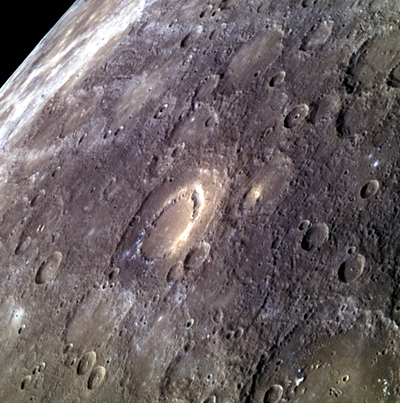Press Release
MESSENGER Completes Its 3,000th Orbit of Mercury, Sets Mark for Closest Approach
Tue, 04/22/2014 - 10:43

Credit: NASA/JHUAPL/Carnegie Institution of Washington
On April 20, MESSENGER completed its 3,000th orbit of Mercury and moved closer to the planet than any spacecraft has been before, dropping to an altitude of 199 kilometers (123.7 miles) above the planet’s surface.
“We are cutting through Mercury’s magnetic field in a different geometry, and that has shed new light on the energetic electron population,” said MESSENGER Project Scientist Ralph McNutt, of the Johns Hopkins University Applied Physics Laboratory (APL) in Laurel, Md. “In addition, we are now spending more time closer to the planet in general — and that has, in turn, increased the opportunities for all of the remote sensing instruments to make higher-resolution observations of the planet.”
MESSENGER has been completing three orbits of Mercury every day since April 2012, when two orbit-correction maneuvers reduced its orbital period about Mercury from 12 hours to 8 hours. The shorter orbit has allowed the science team to explore new questions about Mercury’s composition, geological evolution, and environment that were raised by discoveries made during the first year of orbital operations.
APL’s Carolyn Ernst, the deputy instrument scientist for the Mercury Laser Altimeter (MLA), said the change from a 12- to an 8-hour orbit provided her team with 50% more altimetry tracks. “MLA coverage takes a long time to build up, and because of the small footprint of the laser, a lot of coverage is needed to obtain good spatial resolution. The more data we acquire, the better we resolve the topography of the planet,” she said. “The 8-hour orbit has also allowed us to make more MLA reflectivity measurements, which have provided critical clues for characterizing Mercury’s radar-bright deposits at high northern latitudes.”
The probe has been edging closer and closer to Mercury since March 2013, at about the time that the spacecraft orbit’s minimum altitude passed closest to Mercury’s north pole.
APL’s David Lawrence, a MESSENGER Participating Scientist, said he is excited about what the low-altitude orbits will reveal about Mercury’s surface composition. “To date our compositional measurements with neutron, X-ray, and gamma-ray data have resolved only very large regions on Mercury’s surface. Altitudes of less than 100 kilometers will enable us to pinpoint the compositional signatures of specific geologic features, which in turn will help us to understand how the surface formed and has changed over time.”
MESSENGER’s periapsis altitude will continue to decrease until the first orbit-correction maneuver of the low-altitude campaign, scheduled for June 17.
“The final year of MESSENGER’s orbital operations will be an entirely new mission,” added MESSENGER Principal Investigator Sean Solomon, of Columbia University’s Lamont-Doherty Earth Observatory. “With each orbit, our images, our surface compositional measurements, and our observations of the planet’s magnetic and gravity fields will be higher in resolution than ever before. We will be able to characterize Mercury’s near-surface particle environment for the first time. Mercury has stubbornly held on to many of its secrets, but many will at last be revealed.”
MESSENGER (MErcury Surface, Space ENvironment, GEochemistry, and Ranging) is a NASA-sponsored scientific investigation of the planet Mercury and the first space mission designed to orbit the planet closest to the Sun. The MESSENGER spacecraft was launched on August 3, 2004, and entered orbit about Mercury on March 17, 2011 (March 18, 2011 UTC), to begin a yearlong study of its target planet. MESSENGER's first extended mission began on March 18, 2012, and ended one year later. MESSENGER is now in a second extended mission, which is scheduled to conclude in March 2015. Dr. Sean C. Solomon, the Director of Columbia University's Lamont-Doherty Earth Observatory, leads the mission as Principal Investigator. The Johns Hopkins University Applied Physics Laboratory built and operates the MESSENGER spacecraft and manages this Discovery-class mission for NASA.